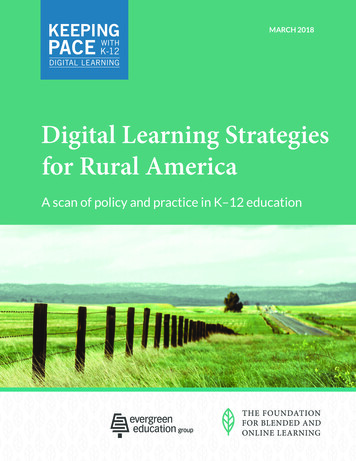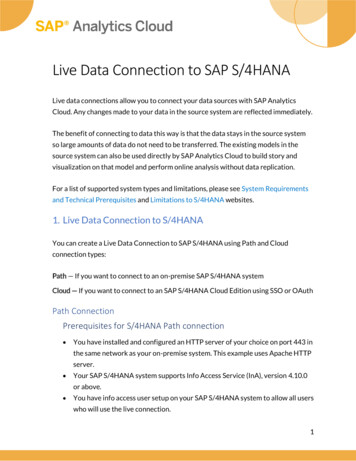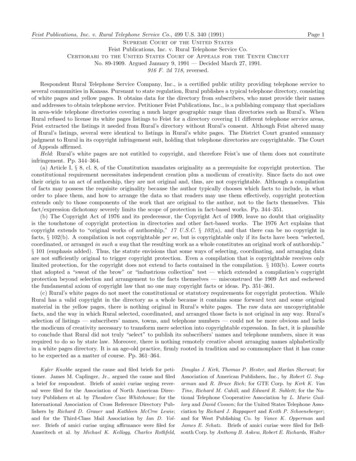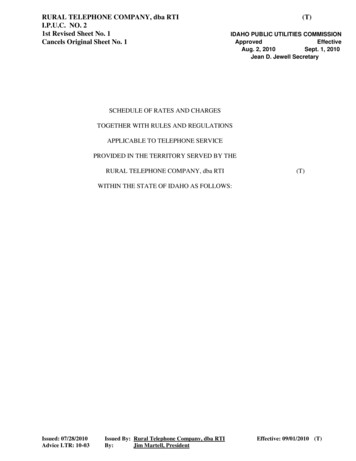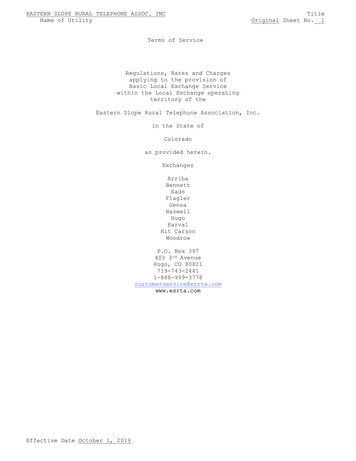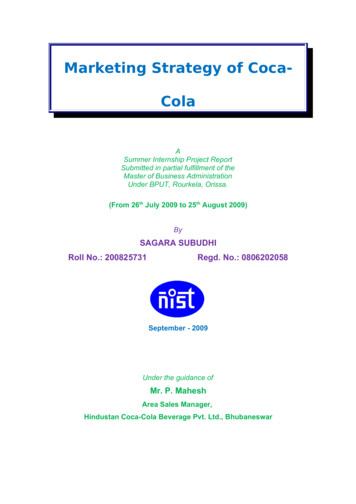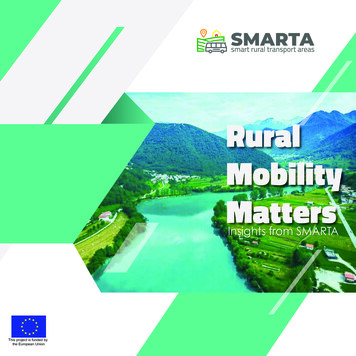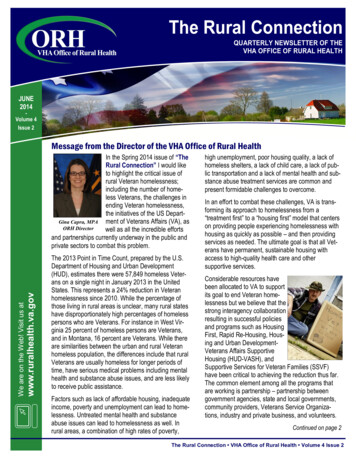
Transcription
The Rural ConnectionQUARTERLY NEWSLETTER OF THEVHA OFFICE OF RURAL HEALTHJUNE2014Volume 4Issue 2Message from the Director of the VHA Office of Rural Healthwww.ruralhealth.va.govWe are on the Web! Visit us atIn the Spring 2014 issue of “TheRural Connection” I would liketo highlight the critical issue ofrural Veteran homelessness;including the number of homeless Veterans, the challenges inending Veteran homelessness,the initiatives of the US DepartGina Capra, MPA ment of Veterans Affairs (VA), asORH Directorwell as all the incredible effortsand partnerships currently underway in the public andprivate sectors to combat this problem.The 2013 Point in Time Count, prepared by the U.S.Department of Housing and Urban Development(HUD), estimates there were 57,849 homeless Veterans on a single night in January 2013 in the UnitedStates. This represents a 24% reduction in Veteranhomelessness since 2010. While the percentage ofthose living in rural areas is unclear, many rural stateshave disproportionately high percentages of homelesspersons who are Veterans. For instance in West Virginia 25 percent of homeless persons are Veterans,and in Montana, 16 percent are Veterans. While thereare similarities between the urban and rural Veteranhomeless population, the differences include that ruralVeterans are usually homeless for longer periods oftime, have serious medical problems including mentalhealth and substance abuse issues, and are less likelyto receive public assistance.Factors such as lack of affordable housing, inadequateincome, poverty and unemployment can lead to homelessness. Untreated mental health and substanceabuse issues can lead to homelessness as well. Inrural areas, a combination of high rates of poverty,high unemployment, poor housing quality, a lack ofhomeless shelters, a lack of child care, a lack of public transportation and a lack of mental health and substance abuse treatment services are common andpresent formidable challenges to overcome.In an effort to combat these challenges, VA is transforming its approach to homelessness from a“treatment first” to a “housing first” model that centerson providing people experiencing homelessness withhousing as quickly as possible – and then providingservices as needed. The ultimate goal is that all Veterans have permanent, sustainable housing withaccess to high-quality health care and othersupportive services.Considerable resources havebeen allocated to VA to supportits goal to end Veteran homelessness but we believe that thestrong interagency collaborationresulting in successful policiesand programs such as HousingFirst, Rapid Re-Housing, Housing and Urban DevelopmentVeterans Affairs SupportiveHousing (HUD-VASH), andSupportive Services for Veteran Families (SSVF)have been critical to achieving the reduction thus far.The common element among all the programs thatare working is partnership – partnership betweengovernment agencies, state and local governments,community providers, Veterans Service Organizations, industry and private business, and volunteers.Continued on page 2The Rural Connection VHA Office of Rural Health Volume 4 Issue 2
The Rural ConnectionMessage from the Director (Continued from page 1)One such interagency partnership is the HUD-VASH program, acollaborative program between HUD and VA where eligiblehomeless Veterans receive rental support from HUD in the formof a Housing Choice or Project Based Section 8 voucher, pairedwith VA provided case management and supportive services tosupport housing stability and recovery from physical and mentalhealth problems, substance use disorders, and functional concerns contributing to or resulting from homelessness. More than46,000 Veterans and their families have been permanentlyhoused through the HUD-VASH program.Under the SSVF program, VAawards grants to private nonprofit organizations and consumer cooperatives who canprovide supportiveservices to very low-incomeVeteran families living in ortransitioning to permanenthousing. SSVF is designed torapidly re-house homelessVeteran families and preventhomelessness for those atimminent risk due to a housingcrisis. Funds are granted toprivate non-profit organizations and consumer cooperatives that will assist very low-income Veteran families by providing a range of supportive services designed to promote housingstability. Grant funding has been awarded to more than 300community-based agencies that serve all 50 states, Puerto Rico,the District of Columbia, and the Virgin Islands. These grantsplay a critical role in addressing Veteran homelessness by assisting our vital partners at the local level in their efforts.Since 2009, the Office of Rural Health (ORH) has invested nearly 20 million dollars in programs aimed at preventing and ending rural Veteran homelessness. Most of this funding has goneto a program known as Mental Health Intensive Case Management – Enhance Rural Access Network for Growth Enhancement (MHICM – ERANGE). This program provides intensivecase management for both at-risk for homelessness and homeless rural Veterans, most of which have serious mental illness.This program includes substance abuse treatment, spiritual care,patient education, provider training, outreach and health servicesVolume 4 Issue 2assertive community based clinical case management.ERANGE promotes, helps maintain, and/or restores the mentalhealth of this Veteran population, and ultimately enables Veterans to live successfully in rural community settings. In addition,ORH has supported a demonstration project in order to evaluatea permanent housing model for homeless rural Veterans knownas the “Lodge Project.” This model, based on the concept developed by George Fairweather, is aimed at psychosocial rehabilitation by providing permanent, independent, self-managedcooperative housing for four to six employed occupants.Results from the demonstration project were promising andORH plans on expanding this model to other rural areas of thecountry.Private efforts to end rural Veteran homeless include those ofthe Housing Assistance Council (HAC). The HAC is a nationalnon-profit organization that supports affordable housing initiatives in rural areas of the country. They provide technical housing services, seed money loans from a revolving fund and housing program and policy assistance. They recently partnered withthe Home Depot Foundation to award grants totaling 265,000to nine local nonprofit housing associations to build or preservehousing for Veterans residing in rural America.It is the stated goal of President Obama, and VA SecretaryShinseki to end Veteran homelessness by 2015. VA along withits partners, in both the private and public arena, is working hardto achieve that goal.To learn more about VA’s homeless programs go towww.va.gov/homeless. To learn more about the HAC go towww.ruralhome.org. USDA Announces Funding for AdvancedCommunications Technology in Rural AreasAgriculture Secretary Tom Vilsack today announced thatthe United States Department of Agriculture (USDA) isaccepting applications for grants to enhance telecommunications and broadcast services in rural areas. Vilsacksaid, "This funding will help small, rural communitiesacross the country gain access to communications technologies to improve health, education and other services."To read the full USDA News Release, visit:http://go.va.gov/55mv. Page 2
The Rural ConnectionWhat you should know about VA Health Care and the Affordable Care ActAt a glance VA wants all Veterans to get health care thatimproves their health and well-being. If a Veteran is enrolled in VA health care, theydon’t need to take additional steps to meet thehealth care law coverage standards. The health care law does not change VA healthbenefits or Veterans’ out-of-pocket costs. If a Veteran is not enrolled in VA health care,they can apply at any time.What is the Affordable Care Act?The Affordable Care Act, also known as the health care law,was created to expand access to affordable health care coverage to all Americans, lower costs, and improve quality andcare coordination. Under the health care law, people will have: health coverage that meets a minimum standard (called“minimum essential coverage”); qualify for an exemption; or make a payment when filing their taxes if they haveaffordable options but remain uninsured.In 2014, Health Insurance Marketplaces will be a new way tofind health coverage. On the Marketplaces, some people maybe eligible for lower costs on premiums and out-of-pocketcosts based on their income.If a Veteran is enrolled in a VAhealth care program, do theymeet the requirement forhealth care coverage?Yes. If a Veteran is enrolled inany of VA’s programs below, theyhave coverage under the standards of the health care law: Veteran’s health care program Civilian Health and Medical program (CHAMPVA) Spina bifida health care programWhat are the benefits of VA health care programs? No enrollment fee, monthly premiums, or deductibles.Most Veterans have no out-of-pocket costs. Some Veterans may have to pay small copayments for health care orprescription drugs. More than 1,400 places available to get your care. Thismeans your coverage can go with you if you travel ormove. Freedom to use other plans with your VA health care,including Medicare, Medicaid, TRICARE or private insurance. You have met the new requirement to have health carecoverage.If Veterans are not enrolled in a VA health care program,how can they apply?Veterans can apply for VA health care at any time by visitingwww.va.gov/healthbenefits/enroll, calling 1-877-222-VETS(8387), or visiting their local VA health care facility.Where can I get more information? Medical care rated among the best in the U.S. Immediate benefits of health care coverage.Visit VA’s website at www.va.gov/aca, or call us at 1-877-222VETS (8387), Monday through Friday from 8 a.m. to 10 p.m.or Saturdays from 11 a.m. to 3 p.m., eastern. Veterans may apply for VA health care enrollment at anytime.For more information about the Marketplace, visitwww.healthcare.gov. Volume 4 Issue 2Page 3
The Rural ConnectionThe Bakken Region – Veterans Health Administration (VHA) Addresses Rural Health Concernsby Alden Borromeo, MHA, Health Systems Specialist, VHA Office of Rural Health and Margaret (Peggy) Wheelden, Public Affairs Officer,Fargo VA Health Care SystemBetween 2010 and 2012, an “oil and gas boom” began in theBakken region (near Williston, North Dakota), which spans northeastern Montana, northwestern North Dakota, and southernCanada.* Over a three year period, thousands of U.S. jobs wereadded to a highly rural area which lacked adequate levels of housing, infrastructure and support services.* Over time, individuals withrelatively high paying oil and gas jobs entered and competed forresources in the local economy, affecting the Veterans Health Administration’s (VHA) and the community’s ability to hire and housenew health care providers to care for increasing numbers of Veterans working in the area.Oil company workers in theBakken region, including manyVeterans, often work shift schedules of three weeks on, one weekoff. High housing prices and thegeneral lack of services and entertainment has translated into oilemployees living in temporaryhousing, referred to as “crewcamps” during the work periodand returning to another location for the time off. The influx of newpopulation to the strained rural community has been associated withincreased alcoholism, drug use, and assaults. This situation is compounded as law enforcement cannot compete with oil company salaries for workforce. State and Federal agencies struggle to keep upwith routine surveillance, prevention and intervention work.Today, clinics run by VHA are nearing maximum operational capacity in the Bakken region. VHA has assessed existing capabilities andresources to address the increase demand for services precipitatedby the increasing Veteran population including access to mentalhealth and substance use care (via telehealth), homeless services,and residential treatment programs for mental health and substanceabuse. Study continues to learn more about the population, itshealth care needs, its migratory patterns, and how these factorshave changed over time. Importantly, other areas in the U.S. areexperiencing a similar local/regional oil boom phenomena and information learned from studying the Bakken region would benefit VHAleaders in those areas.The Fargo VA Medical Health Care System (HCS) oversees theprovision of health care for 31,462 Veterans living in North Dakota,including much of the Bakken Region, as well as 19 counties innorthwest Minnesota, and two counties in northeast South Dakota.Volume 4 Issue 2Nine community based outpatient clinics (CBOC’s) serve Veteransthroughout North Dakota: Jamestown, Bismarck, Dickinson, Minot,Grafton and Grand Forks, and in Minnesota: Fergus Falls, Bemidji,and Williston. In an effort to expand access to primary care in NorthDakota, the Fargo VA HCS will be opening a primary care telehealthclinic in the summer of 2014 in Devils Lake, North Dakota. It willemploy 1 registered nurse, 2 licensed practical nurses, and a primary care provider who will be on site monthly for face to face appointments.Recently, the Fargo VA HCS Director and staff toured the westernCBOCs, met with VA and contract staff, attended a Homeless Veteran Stand-down in Williston, North Dakota, and held Veteran Forums. Both staff and Veterans were appreciative of the Director’svisit and enjoyed the opportunity to express successes as well asopportunities for improvement. The primary challenges identifiedwere transportation and access to specialty care. Fargo VA HCS isexpanding its use of non-VA referrals in these areas, allowing Veterans the opportunity to obtain care in the private sector if not available through their local CBOC and save travel time to Fargo. Of noteis that fact that the private sector does not always have the capacityor specialty clinics in the rural sector, due to provider recruitmentdifficulties in North Dakota.In order to broadly address the Bakken region’s issues, the WhiteHouse Office of National Drug Control Policy (ONDCP) has requested several Federal Departments to engage in a White House Domestic Policy Council (DPC) led, inter-agency effort to assess,strategize and respond to the current situation. The Secretary of theDepartment of Veteran Affairs (SECVA) has tasked the VeteransHealth Administration (VHA) to formalize a workgroup towards theestablishment of a Federal strategy to address the complex challenges associated with the Bakken region.The Bakken Workgroup is co-chaired by Gina Capra, MPA - Director, VHA Office of Rural Health (ORH) and Lavonne Liversage, theFargo VA Medical Center Director. Workgroup membership includes related subject matter experts and representatives from bothfield and program offices at a variety of leadership levels. Ultimately, the Bakken Workgroup will bring key decision points to the VADeputy Under Secretary for Health for Policy and Services, the VADeputy Under Secretary for Health for Operations and Management,and appropriate VA zine/north-dakota-wentboom.html?pagewanted 4& r 0. Page 4
The Rural ConnectionThe Department of Veterans Affairs and the Indian Health Service - A Long History of Partneringby Tim Stroup, BSPharm, R.PH. FAPha, FASHP, Deputy Chief Consultant, VA Pharmacy Benefits ManagementThe Federal Pharmacy Collaboration Council (FPCC) wasformally established on April 1, 2012 to “to foster collaboration, support active/dynamic communication, and encouragesharing of best pharmacy practices across pharmacy programs, services and activitiesof the Federal government inthe advancement of healthcarein the United States.” Both VAand the Indian Health Service(IHS) pharmacy programs aremembers of the FPCC, but thepartnership between VA andIHS has a much longer history,dating back at least 30 years.That history has helped advance pharmacy practice inboth VA and IHS but also has contributed to the advancement of the pharmacy profession in this country.One of the major partnering initiatives is the joint contractingfor pharmaceutical products through the VA National Acquisition Center (NAC), and in particular, the PharmaceuticalPrime Vendor contract (http://www.va.gov/oal/business/nc/ppv.asp) which supports VA and IHS plus other federal pharmacy programs. That contract has total annual sales exceeding 4 Billion and has an estimated cost avoidance of over 380 Million annually. In addition, VA and IHS share in participation and collaboration of their respective formulary processes and clinical pharmacy programs.Another major partnering initiative is the use of the VA Consolidated Mail Outpatient Pharmacy (CMOP) program in support of participating IHS medical centers and clinics. This pilotprogram began in June 2010 under the auspices of the mostrecent VA/IHS memorandum of understanding (MOU) thatallows for tribal partnership and has grown steadily to thecurrent level of over 105,000 prescriptions dispensed duringthe second quarter in fiscal year 2014. Total prescriptionsworkloads for this partnership grew from 2000 prescriptions infiscal year 2010, to over 400,000 prescriptions projected forfiscal year 2014. To date, this partnership has dispensedroughly 700,000 prescriptions in support of 26 IHS clinicalContinued on page 7Looking for a Few Good Investigators!The South Central (VISN 16) Mental Illness, Research, Education and Clinical Center(MIRECC) is looking for Associate Professor or Professor level clinician-investigators whohave a track record of funding and whose research interests are consistent with the MIRECC’s rural theme: “To promote equity in engagement, access, and quality of mental healthcare for Veterans facing barriers to care, especially rural Veterans.” We are particularly interested in investigators who study expanding mental health access to rural-residing personsor employ technology to improve access to treatments. Qualified investigators should bedoctoral level clinical providers and may include psychiatrists, psychologists, social workers, or nurses. A full-time position with acombination of research and clinical duties will be negotiated at one of five possible locations where the South Central MIRECChas a presence: Houston, TX; Jackson, MS; Little Rock, AR; New Orleans, LA; or Oklahoma City, OK. Each VA medical center atthese locations has a close affiliation with an academic institution.The South Central MIRECC was funded in 1998 by Office of Mental Health Services and has been renewed twice, most recently in2012. The South Central MIRECC has strong research, education, and clinical demonstration programs. To learn more about theSouth Central MIRECC, please visit http://www.mirecc.va.gov/visn16.Interested investigators should send a CV and brief letter of interest via email to Mark Kunik, M.D. (mkunik@bcm.edu), Director,South Central MIRECC, Michael E. DeBakey VA Medical Center, Houston, TX. Volume 4 Issue 2Page 5
The Rural ConnectionReaching Out to Indian Country’s Veteransby Terry Bentley, Tribal Government Relations Specialist/Western RegionOn March 20-21, 2014, the VA Office of Tribal GovernmentRelations (OTGR) sponsored a Veterans Training Summit atthe Twin Arrows Navajo Resort and Casino on the NavajoNation Reservation near Flagstaff, Arizona. Attendees includedtribal leaders, tribal health directors, Veterans and Veteran service providers with the goal of sharing information regardingVA benefits and services. The one and half day summit provided an opportunity to network with and hear updates from VAleadership and subject matter experts, share best practicesand collaborate with other state and federal agencies whoserve Veterans. More than 20 speakers and program representatives provided information on VA benefits and servicesavailable to Veterans and their family members.The event in Flagstaff kicks off the 2014 VA/Office of TribalGovernment Relations (OTGR) Veterans Training Summitseries hosted in or near Indian Country. The primary goal ofthese summits is to facilitate increased access to VAhealthcare and benefits through informative presentations andinteractive discussions about VA’s efforts to reach Veteransliving in Indian Country. During FY2012-2013, VA/OTGR held12 regional training summits, reaching approximately 1,200attendees.There are four Tribal Government Relations Specialists acrossthe United States, each of whom have relationships with tribalgovernments within a specific region. These specialists develop connections with tribal leaders, and federal and state partners to enhance the working relationship of the VA with tribalgovernments. Each of the Specialists is an enrolled tribal member and two of them are Veterans.Marvin Trujillo, Director of the Laguna Pueblo Veterans Program in New Mexico and a Gulf War, OIF/OEF Veteran attended the summit in Flagstaff where he was asked about the im-portance of theseevents. Marvin replied,“These trainings educate Indian Veteranson the available access to VA benefitsand SecretaryMarvin Trujillo, DirectorLaguna Pueblo Veterans ProgramShinseki’s initiative toreach out specificallyto Indian Veterans. It’s important for us to realize the priorityhe places on our access to healthcare and benefits. Outreachto Indian Veterans especially in rural communities, like thisone – it’s new to us. It didn’t used to be like this. There wasn’tenough outreach before OTGR started connecting with Veterans in their communities and holding summits for us to gatherand educate ourselves.”Stephanie Birdwell, Director of OTGR, says that these summits offer “An important forum not only to bring together VA,state, Veteran Service Organizations and other agency partners, but also to share information with tribal leaders, serviceproviders and to Veterans and their families living in IndianCountry who don’t always have ready access to these services or access to those who can offer a road map to helpnavigate the various systems that serve Veterans. These areservices and benefits that Veterans have earned through theirservice, and often times they are opportunities that can be lifechanging. Long after the summit is over, the contacts, relationships and partnership opportunities move forward and greateraccess is achieved for our Veterans within tribal communities.”Visit the OGTR website to learn more about the importantwork of this office as well as upcoming training summits andother OTGR sponsored events.http://www.va.gov/tribalgovernment/upcoming events.asp. Service Member to Civilian:A National Summit on Improving TransitionsDecember 1-3, 2014Honor our nation’s service members from all branches of the military transitioning to civilian life. Local, state, and federal partners will use thisconference to explore education, translational research, and employment dynamics to remove physical, mental, emotional, financial, employment and educational barriers. Learn more by visiting http://training.ua.edu/military-support. Paper/Poster submissions due June 30, 2014!Volume 4 Issue 2Page 6
The Rural ConnectionWorking with Community Partners to Serve Veteransby Ella Robbins, RN ,Salem VA Medical CenterThis past February the Rural Health Team at the Salem VAMedical Center in Salem, Virginia, in partnership with theVirginia Wounded Warrior Program, organized and sponsoreda one-day conference titled “Working with Community Partners to Serve Veterans.” The purpose of this conference wasto provide educational information on VA services and benefits, as well as to promote collaboration emphasize theimportance of forming local public–private partnerships tobridge knowledge gaps and identify barriers to care for ruralVeterans. Continuing Medical Education (CME) and EducationCredits were provided by the University of Virginia.Over 70 attendees, including local non-VA health care providers, heard from VA experts on recognizing the signs andsymptoms of posttraumatic stress disorder (PTSD) and traumatic brain injury (TBI) in their Veteran patients; on crisis inter-vention; and oninnovative VAprograms suchas home basedprimary care(HBPC), hometelehealth andVeteran transportation. Apresentation wasalso given on how to use My HealtheVet, VA’s online personalhealth record. In order to simplify future communicationbetween the Salem VA medical center and community entities,contact names and phone numbers from each of VA’s departments and conference attendees were exchanged at the endof the day. VA/HHS Initiative to Improve Care Coordination for Rural Veterans (Continued from page 5)sites with another 26 electronically connected to CMOP thatare included in the total of 78 sites set up to utilize CMOP,including three Tribal facilities.CAPT Pam Schweitzer was recently recognized for her contributions to the VA/IHS partnership, including the VA/IHS CMOPinitiative, by being named to receive the 2014 American Pharmacist Association (APhA) Distinguished Pharmacist Award atthe APhA Federal Pharmacy Forum last March in Orlando, FL.This forum includes nearly 100pharmacists and pharmacy technicians from the US Army, Navy,Air Force, Coast Guard, PublicCAPT Pam SchweitzerHealth Service, Indian HealthService, Bureau of Prisons, and VA. CAPT Schweitzer is apast Chief Pharmacist at the VA Medical Center in HotSprings, South Dakota, prior to serving as the Director of theIHS Pharmacy Resident Program. She is currently serving asthe Senior Staff Health Insurance Specialist at the Centers forMedicare and Medicaid Services (CMS).Volume 4 Issue 2Other successful VA and IHS joint initiatives have includedprograms such as Medication Reconciliation, MedicationSafety, Clinical Pharmacy Scope of Practice, Pharmacy Technician training and others. In the future, VA and IHS plan oncollaborating on an Indian Health Pharmacy Residency program. There will be 19 residencies located in South Dakota,Alaska, New Mexico, North Carolina, Arizona, Oklahoma andOregon training 23 post graduate year 1 (PGY1) pharmacyresidents for the academic year 2014 -2015. The VA Pharmacy Resident program currently has 225 Pharmacy Residencyprograms that include 600 Pharmacy Residency positions(PGY1/PGY2) nationwide which represents approximately20% of all American Society Health-System Pharmacists(ASHP) accredited Pharmacy residencies in this country.Learn more about the Indian Health Service PharmacyResidency Program here http://www.ihs.gov/pharmacy/resident. VA Reaching Out to Rural Veterans. Read about theAlabama Veterans Rural Health Initiative (AVRHI) and howenhanced community outreach in rural areas improvedVeterans’ access to care. Visit Reaching-Out-to-RuralVeterans.asp. Page 7
The Rural ConnectionWhat’s YOUR health age?Take the ‘healtheliving’ assessment to find out. The healtheliving assessment is the first step to making healthy changes. This onlinetool asks you questions about your health history and habits. For example, there are questions about your family health history and lifestyle choices. It also includes reports. Your reports show you your health age, current health status, and suggestions to improve yourhealth – and lower your risk of disease.Jay Shiffler, a 20-year Army Veteran, took the healtheliving assessment recently. His health age “was not quite what I’d hoped it wouldbe. One of the indicators in the healtheliving assessment was my weight. My BMI (Body Mass Index) was too high, and it showed methat there are larger implications than say, just knee and back pain. I found it reassuring that it is completely confidential. I don’t have totalk about some of these things in front of a doctor. I can do this all in the privacy of my own home.”Receive personalized reports The summary report in the healtheliving assessment shows Veterans the positive effect of makingchanges. With graphic displays, it offers Veterans the chance to see the impact of specific changes. “It says ‘here are some things youmight want to do to improve your health age’,” noted Shiffler. “You can select the recommendations to recalculate your health age. Ithelped me focus on what I needed to improve.”Why should Veterans take the healtheliving assessment? It’s confidential, safe, and secure. No one has access to answers andreports unless Veterans decide to share them. It’s quick, free, and easy. No appointments, no waiting — it can becompleted online, in about 20 minutes. It’s informative and personalized. Veterans get specific recommendationson how to improve their health. No information will affect any VA benefits or disability ratings.How can the healtheliving assessment help Veterans reach their goals?Explore and learn: Walk more? Eat better? Try the interactive feature to learn how making these changes can improve your health age.Share with your doctor and health care team: Reaching your health goals can be easier if you choose to share your healthelivingassessment reports with your health care team.Set goals for healthy change: Use this assessment to help you make a plan to improve your health.Three easy steps to the healtheliving assessment: Log in to your online account at My HealtheVet — http://www.myhealth.va.gov.(If you’re new to My HealtheVet, you can register for an online account now .) Select the healtheliving assessment icon. Complete the assessment and find out your health age today! VHA Office of Rural Health“Using Innovation and Technology to Improve Access and Quality”Gina Capra, MPA, DirectorThomas Klobucar, PhD, Deputy Directorwww.ruralhealth.va.govMs. Patricia Vandenberg, Assistant Deputy Under Secretaryfor Health for Policy and PlanningThe Rural Connection Editorial Team:Nancy Maher, PhD, EditorKristen Wing, Co-EditorDesign/Layout by Kristen WingQuestions? Comments? Please feel free toemail us at: rural.health.inquiry@va.gov
the Home Depot Foundation to award grants totaling 265,000 . In 2014, Health Insurance Marketplaces will be a new way to find health coverage. On the Marketplaces, some people may . Veterans may apply for VA health care enrollment at any time. No enrol



